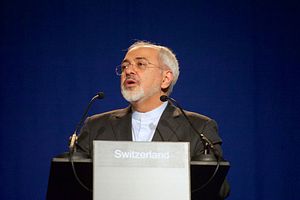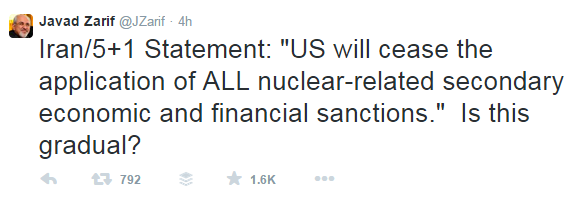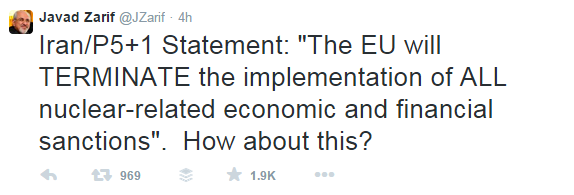As I covered earlier, the framework agreement that the P5+1 group of powers and Iran reached earlier today in Lausanne, Switzerland is historic by all means. Both sides have managed to overcome months of gridlock since the November 2013 interim Joint Plan of Action was passed, charting a road map for a comprehensive deal. As I noted in that post, written shortly after the P5+1 released a fact sheet on the specifics of the agreement, the deal is more than satisfactory when it comes to limiting Iran’s enrichment capacity and granting unprecedented access to international inspectors.
Still, despite all the positives, there is one devilish detail that could yet derail the entire process. How will sanctions relief proceed?
Indeed, one troubling tweet from the Iranian foreign minister, shortly after the release of the P5+1 fact sheet, reveals a gap in understanding on this matter. Zarif, shortly after delivering an exuberant speech, announcing the terms of the deal, tweeted the following:
He immediately followed that tweet with this one:
The final three words of each of those tweets should raise eyebrows about the extent to which this framework agreement is truly a complete and comprehensive road map to a deal. The Iran deal is far from done.
The Iranian foreign minister’s questions reveal the extent to which the days leading up to the end of June 2015 won’t be a cakewalk; these negotiators aren’t simply going to return to the table and write out the details with zero diplomatic friction. The fact of the matter is that Iran has given up a lot per this framework agreement: it’s down to around 6,000 centrifuges from 19,000, it’ll retain just 3 percent of its enriched uranium, it’ll be barred from enriching uranium above 3.67 percent, it’ll dismantle its IR-40 heavy-water reactor at Arak, it’ll be barred from reprocessing spent fuel, and it’ll have to make do with clunky IR-1 centrifuges (to name just a few highlights of Iran’s technical concessions). In technical terms, this deal is a coup for the P5+1 and significantly reduces the scope and strength of Iran’s nuclear program.
In exchange for these concessions, however, Iran is being assured sanctions relief by the European Union and the United States. (An important note here is that the sanctions relief applies solely to nuclear-related sanctions — sanctions for Iran’s support of terror groups, abuse of human rights, and other issues will remain in place.) Zarif’s candid tweets highlight the phrases in the P5+1’s language that need the most clarification. How will sanctions relief proceed? With a lack of trust between Iran and world powers, how can Iran make the first move without a guarantee that it’ll be worth it in the end? Finally, if you’ve at all been following the public debate on the Iran negotiations in the United States, you’ll know just how politically unfeasible it will be for the United States to make the first move by rolling back sanctions (sanctions, I might add, that will be very difficult to reverse should Iran refuse to comply with its end of the bargain, particularly at the UN Security Council).
This will be the multi-billion dollar question for Iran heading toward June 30. Despite today’s exuberant announcements, it will be wise for observers — both critics and supporters of the Iran deal — to remain vigilant on the sanctions relief issue. In my view, the success of the deal will come down largely to how far the P5+1 are willing to trust Iran to fully comply with the implementation of every technical concession outlined in the framework. I think we’ve seen the end of the line in terms of how much Iran is willing to concede when it comes to the nuts-and-bolts of its nuclear program, and to be frank, the concessions are great. It’s down to the P5+1 now to find a way to approach the sanctions relief issue in a way that is both tenable, feasible, and inoffensive to Tehran — something easier said than done.



































